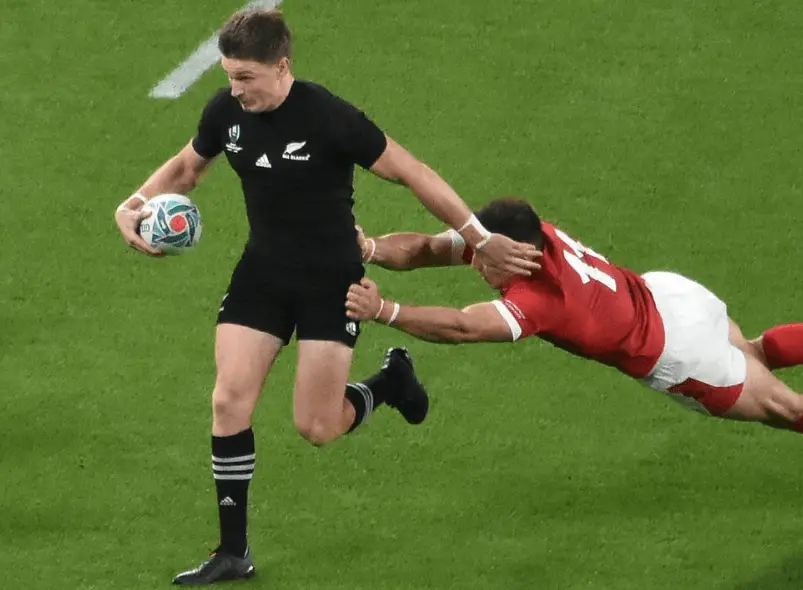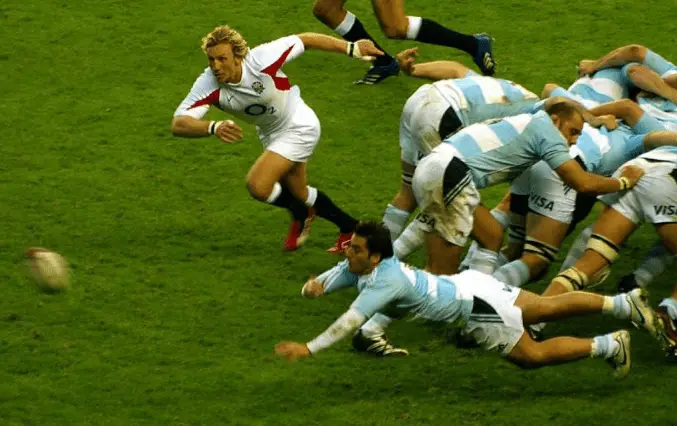Rugby is an incredibly skillful game with an abundance of options available to the player at every moment. The variety of skills possible is what makes it so much fun for myself and many others to watch and play. But, what are the specific skills needed to be good at rugby? Well, I did my research and came up with this list.
The skills needed to be good at rugby fall into 5 distinct categories, which are: handling, running, passing, tackling, contact, and kicking skills. Some of the most common skills are the: side step, hand off, spiral pass, pass off the floor, side on tackle, head on tackle, smother tackle, hit and spin, punt, drop kick and place kick.
The Core Skills Needed For Rugby:
| Skill Area | Skill |
| Running | Side step Swerve Hand off Support line running Defensive positioning |
| Passing | Passing Receiving a pass Catching high balls Pick-ups off the ground Spiral pass Pass off the ground Dive pass Lob pass Pass through the tackle Falling to the ground to pick up the ball |
| Tackle | Side-on tackle Falling in the tackle Front on tackle Tackle from behind Smother tackle |
| Contact | Hit and engage Hit and spin Hit and pass Hit and go to the ground |
| Kicks | Punt Drop kick Grubber Up and Under Spiral bomb Chip Drop punt Place kick |
Let’s take a quick look at the five categories of rugby skills and get an over view of exactly what they are. You’ll find links to more in depth ‘how to’ guides throughout this article so you can get all the detail you need.
Running Rugby Skills
The sidestep is an easy to learn skill that is used to wrong foot an opponent and allow you to run past them. Any player in any position can execute this skill if they get their timing right. The real key to the sidestep is to use the eyes to deceive your opponent. Read my detailed guide to the sidestep here. The sidestep works particularly well in conjunction with the body swerve, either just before or just after it.

The body swerve is essentially a move just as it sounds, a swerve around an opponent using the hips to make an arc around them. My full guide to the sidestep and swerve is here and also covers the hand off. A hand off works particularly well alongside the body swerve as it allows you to fend off/push away a tackler as you go around them. It’s a great feeling when you push some over on the run 🙂
Running good support lines is also important in rugby. The player needs someone to pass to right, and the more options they have the more difficult it is for the team without the ball to defend. However, knowing the right lines to run in order to be in the right place at the right time is more difficult and comes with experience and trusting your instinct.
Similarly, you have to be able to play a role in the defensive line of your team communicating with them who you are marking and which way you need others to move in order to keep the defensive line flat. If you can’t play your role in the defensive line effectively then your chances of being selected are much less.
Rugby Handling Skills
Learning how to catch a ball is a crucial first skill to master and it is not quite as easy as it sounds. You need to have your arms and fingers stretched out towards the direction of the ball providing a target for the passer. You need to communicate with them where you are and you need to do this whilst running and scanning the opposition defense for gaps.

After catching the ball you may well want to pass it. There are at least six basic types of rugby pass and probably a few more besides each requiring their own specific technique, nuance and style, and each suited a slightly different game situation. Why not jump into my complete how to guide to passing the rugby ball here.
Picking the ball up off the floor, placing the ball back in the tackle and placing the ball on the ground are all also important skills to master early on in your rugby journey.
The ability to take a mark is also a key skill not to be overlooked for back three players.
Rugby Tackling Skills
Many people enjoy playing rugby because of the physical contact that they can get involved in. However, effective tackling is not just about size and strength. It is just as much about technique and timing. This is why smaller players can still compete against bigger players. Anyone who saw Jonny Wilkinson knock backwards bigger players repeatedly will attest to this.
There are a variety of different types of tackles which all need to be learned, including the: head on tackle, side on tackle, tackle from behind, tap tackle, smoother tackle, chop tackle, double tackle to name but a few.
Another important consideration regarding tackles is safety. In recent years multiple studies have suggested that repeated head knocks and concussions in rugby can lead to difficulties surrounding memory later on in life. Using correct tackle technique is one way of mitigating against head knocks and so is another reason it should be learnt correctly and practiced by all players. Check out our guide to tackling and technique here.
Rugby Contact Skills
So, once you have charged into the opposition at full speed, how are you going to keep possession of the ball? And what are you going to do with it anyway? Well, this will depend largely on how good your contact skills are.
Your main options and the skills you need to master for contact are: the hit and engage, the hit and spin out of the tackle, the hit and pass, and the hit and go to ground. These skills help you to keep the ball alive na sleep making progress for your team.
If you lose the ball every time you go into contact or don’t know how to protect it or get it back to your teammates then you are going to be a weak link in the team. Read my full guide to rugby contact skills here.
Rugby Kicking Skills
Kicking is necessary in rugby for a variety of reasons. Firstly, you might want to kick in open play to clear your lines and gain territory with a punt or spiral kick. You may want to turn the opposition defense and stop them from rushing up all the time with a grubber kick or chip kick.
You might also want to test out the opposition back three players by hitting an up and under early in the game or anytime there is bad weather. And then of course you will need to use a drop kick to restart play and also as an option to score three points from open play in close games.
Finally, the most important kick is perhaps the place kick, used for kicking penalties worth three points or conversions following a try for two points. An accurate place kicker who can kick them from distance is worth their weight in gold! If you want to get improve your kicking technique then check out my detailed guide to the different types of kicks and how to execute them like a pro!
Whilst some people despise kicking and find it ‘boring’ others who appreciate the strategy and tactics behind it can find it a fascinating aspect of play, read my guide here as to why people kick so much in rugby.
20 Outrageously Skillful Moments In Rugby
So, that is my quick overview of the skills required to be successful in rugby. I go into far more detail on each of these skills on the articles that I have linked through throughout this post so please go and check them out for a much greater level of detail, or check out my basic rules of rugby guide, here. And for getting this far down the post you definitely deserve to see this great selection of rugby skills:
Suggested Reading: Why Do Rugby Players Put Their Hands Up?
Photo Credits:
Featured image: Jonny Wilkinson 2009 Paddy-K from Flickr, CC BY-SA 2.0, via Wikimedia Commons.
Photo 2 – Beauden Barrett 2019, 江戸村のとくぞう, CC BY-SA 4.0, via Wikimedia Commons.
Photo 3 – A flying pass by Argentina from the back of a scrum during a match against England at Twickenham Stadium in 2006. Catherine Trigg, CC BY 2.0, via Wikimedia Commons

